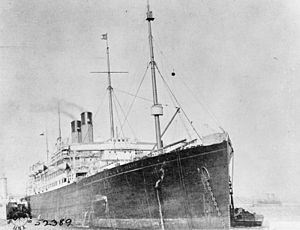
Back RMS Celtic (1901) Czech Celtic (Schiff, 1901) German RMS Celtic (1901) Spanish Celtic (laev 1901) Estonian آراماس سلتیک (۱۹۰۱) Persian Celtic (paquebot de 1901) French RMS Celtic Hungarian Celtic (schip, 1901) Dutch RMS Celtic (1901) Portuguese RMS Celtic (1901) Russian
 RMS Celtic in 1919
| |
| History | |
|---|---|
| Name | RMS Celtic |
| Namesake | Celtic Sea |
| Owner | White Star Line |
| Route | Liverpool - New York City |
| Builder | Harland and Wolff, Belfast |
| Yard number | 335 |
| Laid down | 22 March 1899 |
| Launched | 4 April 1901 |
| Completed | 11 July 1901 |
| Maiden voyage | 25 July 1901 |
| Identification | Number: 113476 Code Signal: SMBF[1] |
| Fate | Grounded on rocks off Cobh, Ireland on 10 December 1928, scrapped on site. |
| General characteristics | |
| Class and type | Big-Four class |
| Tonnage | 20,904 GRT, 13,449 NRT[2] |
| Length | 701 ft (214 m) |
| Beam | 75 ft (23 m) |
| Installed power | 14,000 ihp (10,000 kW) |
| Propulsion |
|
| Speed | 16 kn (18 mph; 30 km/h) |
| Capacity |
|
| Crew | 335 |
RMS Celtic was an ocean liner owned by the White Star Line. The first ship larger than SS Great Eastern by gross register tonnage (it was also 9 ft [2.7 m] longer), Celtic was the first of a quartet of ships over 20,000 tons, the dubbed The Big Four.[4] She was the last ship ordered by Thomas Henry Ismay before his death in 1899. The second liner of her name (the first was completed in 1872) she was put into service in 1901. Her large size (she could carry nearly 3,000 passengers) and her low but economical speed (16 kn or 30 km/h, while her contemporary liners then sailed on average at 19–20 kn or 35–37 km/h) inaugurated a new company policy aiming to favour size, luxury and comfort, to the detriment of speed.
Assigned to the route between Liverpool and New York, Celtic experimented with a mode of slower than usual rotations, but was also used for a long cruise in 1902 which met with some success. In 1907, she was briefly used for the American Line on the Southampton route, before White Star set up its own fast service on this route. From Liverpool, the Big Four-class ships provide a slow but more economical service, both for the company and for the passengers. When World War I broke out, Celtic was first converted to an auxiliary cruiser. The Admiralty quickly concluded, however, that such a ship was not ideal for these functions, and transformed her into a troop transport. She struck a mine in February 1917, then was torpedoed in March 1918, but she was successfully repaired and salvaged both times.
From 1920, and after having undergone a refit reducing her passenger capacity, she resumed her transatlantic service, which was only disturbed by a few collisions. However, this commercial career ceased on 10 December 1928, when, in stormy seas as she approached Cobh, Celtic grounded on the rocks. All the passengers were rescued, but the company considered it futile to attempt to salvage the liner so Celtic was scrapped on the spot. The shipbreaking operation lasted until 1933.
- ^ Malan 1904.
- ^ "Celtic (1113476)". Miramar Ship Index. Retrieved 22 September 2019.
- ^ Arnold Kludas. Great Passenger Ships of the World Vol 1 1858-1912. Patrick Stephens Ltd. p. 90. ISBN 0-85059-174-0.
- ^ * Roberts, Chalmers (August 1901). "The Biggest Ship". The World's Work: A History of Our Time. II: 1176–1179. Retrieved 9 July 2009.
© MMXXIII Rich X Search. We shall prevail. All rights reserved. Rich X Search